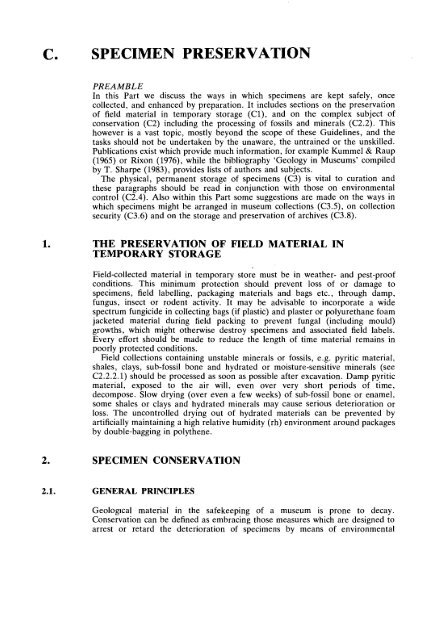GUIDELINES FOR THE CURATION OF GEOLOGICAL MATERIALS
GUIDELINES FOR THE CURATION OF GEOLOGICAL MATERIALS
GUIDELINES FOR THE CURATION OF GEOLOGICAL MATERIALS
You also want an ePaper? Increase the reach of your titles
YUMPU automatically turns print PDFs into web optimized ePapers that Google loves.
SPECIMEN PRESERVATION <br />
PREAMBLE<br />
In this Part we discuss the ways in which specimens are kept safely, once<br />
collected, and enhanced by preparation. It includes sections on the preservation<br />
of field material in temporary storage (Cl), and on the complex subject of<br />
conservation (C2) including the processing of fossils and minerals (C2.2). This<br />
however is a vast topic, mostly beyond the scope of these Guidelines, and the<br />
tasks should not be undertaken by the unaware, the untrained or the unskilled.<br />
Publications exist which provide much information, for example Kummel & Raup<br />
(1965) or Rixon (1976), while the bibliography 'Geology in Museums' compiled<br />
by T. Sharpe (1983), provides lists of authors and subjects.<br />
The physical, permanent storage of specimens (C3) is vital to curation and<br />
these paragraphs should be read in conjunction with those on environmental<br />
control (C2.4). Also within this Part some suggestions are made on the ways in<br />
which specimens might be arranged in museum collections (C3.5), on collection<br />
security (C3.6) and on the storage and preservation of archives (C3.8).<br />
<strong>THE</strong> PRESERVATION <strong>OF</strong> FIELD MATERIAL IN<br />
TEMPORARY STORAGE<br />
Field-collected material in temporary store must be in weather- and pest-proof<br />
conditions. This minimum protection should prevent loss of or damage to<br />
specimens, field labelling, packaging materials and bags etc., through damp,<br />
fungus, insect or rodent activity. It may be advisable to incorporate a wide<br />
spectrum fungicide in collecting bags (if plastic) and plaster or polyurethane foam<br />
jacketed material during field packing to prevent fungal (including mould)<br />
growths, which might otherwise destroy specimens and associated field labels.<br />
Every effort should be made to reduce the length of time material remains in<br />
poorly protected conditions.<br />
Field collections containing unstable minerals or fossils, e.g. pyritic material,<br />
shales, clays, sub-fossil bone and hydrated or moisture-sensitive minerals (see<br />
C2.2.2.1) should be processed as soon as possible after excavation. Damp pyritic<br />
material, exposed to the air will, even over very short periods of time,<br />
decompose. Slow drying (over even a few weeks) of sub-fossil bone or enamel,<br />
some shales or clays and hydrated minerals may cause serious deterioration or<br />
loss. The uncontrolled drying out of hydrated materials can be prevented by<br />
artificially maintaining a high relative humidity (rh) environment around packages<br />
by double-bagging in polythene.<br />
SPECIMEN CONSERVATION<br />
GENERAL PRINCIPLES<br />
Geological material in the safekeeping of a museum is prone to decay.<br />
Conservation can be defined as embracing those measures which are designed to<br />
arrest or retard the deterioration of specimens by means of environmental

















